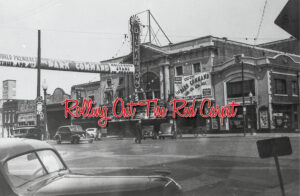| story by | |
| Historical Research & Archival Consulting | |
| photos by | Steven Hertzog |
| OPEN A PDF OF THE ARTICLE |
The history of this nearby lake is unique and preserved because of newspapers created by a civilian corps of Black workers.

Lone Star
Located approximately 10 miles southwest of the City of Lawrence, Lone Star Lake and its surrounding park provides campsites, restrooms with showers, a playground with a volleyball net, a swimming beach, fishing, boating and water skiing, and shelters for picnics and group gatherings. A community building can be rented for family and group events.
Interestingly, Lone Star Lake was built by Civilian Conservation Corps (CCC) Co. 767, and the members of Co. 767 were African American. Co. 767 was one of only five “colored” companies in Kansas. The CCC was an important part of Franklin D. Roosevelt’s New Deal in the 1930s, which provided voluntary public work relief during the Great Depression and operated from 1933 to 1942 in the United States for unemployed, unmarried men ages 18 through 25, eventually expanding to ages 17 through 28.
Kansas was requested to recruit 1,106 enrollees by working with the state board of social welfare and county welfare offices. Potential enrollees had to be vetted on financial need and character. The CCC evolved from an emergency public-relief program to “a permanent governmental provision to teach capable young men trades which they can use later in private employment, and at the same time to build up the physical and raise the standards of health in that age-group.” The monthly pay for enrollees was $30, and they were required to share $22 to $25 with their dependents. The remainder was spending money because living necessities and clothing were provided by the Corps. If an enrollee had no dependents, he was required to deposit the bulk of his salary with the Chief of Finance, War Department. The enrollee could withdraw the money saved at the end of his enrollment period. In 1937, it was estimated that $1,354,789.25 was sent to dependents of CCC enrollees.
A number of the CCC companies published newspapers of their activities, with the Lone Star Gazer, providing information about Co. 767. The first issue appeared May 1, 1936, and was printed on a mimeograph machine. The newspapers were compiled by enrollees who participated in a journalism class and prepared the Gazer on their own time, as they had to meet their required “labor” hours, as well.
The first issue of the Gazer reported that the camp had received 21 new enrollees. Thirteen were from Kansas City, five from Topeka, two from Olathe and one each from Lawrence and Iowa. The young men lived in barracks and took meals at a mess hall. According to one issue, the young men were to plant flowers at their barracks. Enrollees were encouraged to write home “regularly and often,” and to send their copies of the Gazer to their families. One issue contained a reminder about Mother’s Day.
Articles reported on improvements to camp facilities, such as adding a flush toilet and shower in the hospital. A 60- by 60-inch water filter tank was constructed west of the stone water tower. It was reported that the water was being filtered at a rate of 200 gallons per minute. One article reported the earth fill work was progressing. It stated:
Approximately thirty-one thousand yards of dirt have been added to the fill during the month. That is highly commendable considering the adverse conditions under which the enrollees had to labor; temperatures ranging from one hundred degrees upward, hot winds, the accumulated dust until at times it formed a veritable screed. A new barrow pit was opened which produced more moist dirt. Water was conserved to a degree, yardage was added, more compaction was gained, and all in all, the new pit is developing well.
The Gazer had several gossip columns containing information about the personal activities of the men in camp. One of the columns was titled “Speedy Says.”

Signs at an entry point to Lone Star Lake and a WPA concrete bridge
Various glimpses of camp life were provided. Barracks members were encouraged to keep their living facilities clean. Weekly cleanliness contests were held, and one winner received a new Philco radio. There was a weekly movie night, Wednesday, and the title of the movies to be shown were listed, as were titles of the movies being shown at the Lawrence movie theaters.
The educational efforts of the CCC at Co. 767 were also reported. Thirty tractor drivers and machinists attend a two-day school that showed films about how to operate the equipment being used on the project. Enrollees were encouraged to sign up for classes in reading, writing, spelling, penmanship, constitution, negro history, mathematics, typing First Aid and English. Attendance at the negro history call class was encouraged as follows: “Just a suggestion to some of you, the class in Negro History should prove interesting. It is really surprising how little some of you know about the history of your own race.”
The newspaper contained a sports page that reported on the exploits of the camp baseball and softball teams. The baseball team played teams from other camps. Softball teams from each barracks were organized, and they formed a league to play each other. The cover of the September 1936 Gazer featured Jesse Owens after his triumphs at the 1936 Olympics.
The newspaper also featured reports on various social activities. These included dance parties with girls brought from Lawrence to partner with young men. One party featured a band called the Rhythm Ramblers, from Topeka, and it was noted that ice cream, cookies and beer were served. A group of enrollees attend one of the Kansas Relays. The Gazer reported: “Upon the return of the men from the relays, they recounted a fine time enjoying all of the thrilling events, especially in the 100 yrd. Dash which was captured by a Pittsburgh Teachers College Negroe youth.”
Testimonials from enrollees about the value of the CCC were featured in several issues.
Walter Edward Lee was born in 1910 and enrolled in June 1933. He had been working in tree surgery and landscape gardening before joining the CCC.
The camp has taught me discipline and has given me a general knowledge of labor and dam construction. … I think the C.C.C. is one of the greatest mobilization acts completed by any peace time movement by any Government without forcing the measure. It has benefited me more than I could say, off-hand. I have derived a type of Knowledge that will aid me in getting employment after I leave as a Mechanic, Truck driver Kat skinner, Grader-man and have through experience with others learned much which will benefit me otherwise.
Another enrollee was Peter George Andrews who was born in 1914 in Wichita. He was working at a garage when he joined. He held a number of jobs while in camp, including working on the camp survey crew, as a tool checker and as a truck master. In his testimonial, he writes: “I have learned to control my temper since I’ve been here improved my typing and learned to administer First Aid. … Having been here so long it is needless for me to say that this has been a benefit to me physically, morally and socially.” He also stated the being in the CCC aided him financially.
When Lone Star Lake was completed, it was 1400 feet long and had a 45-foot-high earthen dam. The lake eventually consisted of nearly 200 acres. The last step was stocking it with fish. On March 18, 1938, 25,000 fish were placed in the lake by the Kansas Fish and Game Commission. There were 12,500 croppie and the same number of speckled bass. Catfish were already present in the lake.
Because a number of CCC camps published newspapers that gave day-to-day details of life in the camps and were preserved, they are an invaluable historical resource. Because the Lone Star Gazer was from a camp of African American enrollees, the content is even more valuable. It also documents the goals of the CCC to provide educational opportunities and technical training, as well as work relief on important community projects.
![]()




